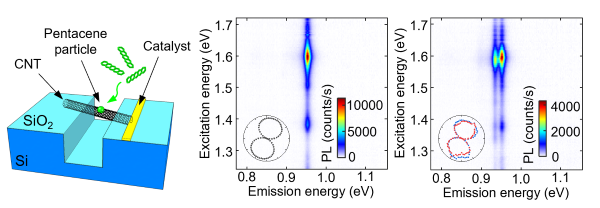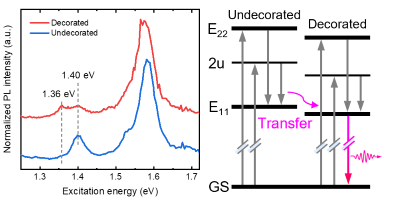Research:Quantum emission assisted by energy landscape modification in pentacene-decorated carbon nanotubes
Single-photon sources are a crucial component for quantum information processing, and photoluminescent carbon nanotubes (CNTs) have emerged as one of the promising candidates. Since the optical response of CNTs is dominated by tightly bound electron-hole pairs, the so-called excitons, various approaches have been proposed to manipulate the motion of excitons so that room-temperature single-photon emission can be achieved. So far, exciton localization via covalent functionalization, spontaneous exciton localization due to disorders, and diffusion-driven exciton-exciton annihilation (EEA) have been proven to be effective approaches.
Because of the atomically thin nature of CNTs, excitons in air-suspended CNTs are highly sensitive to the dielectric environment and any perturbation will result in a significant change in the excitonic energies. Here, by noncovalently decorating air-suspended CNTs with nanoscale pentacene particles, we demonstrate a novel approach to modify the exciton energy landscape and induce single-photon emission at room temperature.
Pentacene particles with diameters less than 100 nm are decorated on individual CNTs by thermal evaporation. Then, photoluminescence excitation (PLE) spectroscopy and photoluminescence (PL) imaging are performed to characterize the CNTs decorated with pentacene. Due to the dielectric screening effect introduced by the decorated pentacene particle, the exciton energy at the decorated site is lowered, which gives rise to an additional main peak with redshifted E11 and E22 resonance energies in the PLE map.

Due to the change in the energy landscape, excitons transfer from the undecorated region to the decorated site as evidenced by the behavior of the weaker 2u peaks in the PLE map. In both undecorated and decorated regions, excitons are generated simultaneously by laser excitation. The excitons from the decorated site are at a lower 2u state due to dielectric screening, and they relax to the lower E11 state to recombine radiatively. Meanwhile, the excitons from the undecorated region are at a higher 2u state, and they transfer to the decorated site with a lower 2u state followed by radiative recombination from the same lower E11 state. This exciton transfer process gives rise to two 2u peaks with the same redshifted E11 resonance energy, but with a redshifted and an unshifted excitation energy. Furthermore, because no extra 2u peaks are observed in the undecorated PLE spectrum, we conclude that the excitons predominantly transfer from the undecorated region to the decorated site.

Finally, excitation power dependence of the PL intensities corresponding to different emission peaks indicates that enhanced EEA is achieved at the decorated site due to the directional exciton transfer and exciton trapping. Room-temperature single-photon emission is demonstrated in a typical pentacene-decorated CNT by photon correlation measurements, and measurements of more CNTs suggest that pentacene particles are generally beneficial for stronger photon antibunching.

To learn more about this work, please refer to:
Quantum emission assisted by energy landscape modification in pentacene-decorated carbon nanotubes
ACS Photonics
8, 2367 (2021).
![]()